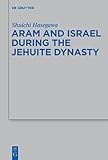Aram and Israel during the Jehuite Dynasty / Shuichi Hasegawa.
Material type: TextSeries: Beihefte zur Zeitschrift für die alttestamentliche Wissenschaft ; 434Publisher: Berlin ; Boston : De Gruyter, [2012]Copyright date: ©2012Description: 1 online resource (209 p.)Content type:
TextSeries: Beihefte zur Zeitschrift für die alttestamentliche Wissenschaft ; 434Publisher: Berlin ; Boston : De Gruyter, [2012]Copyright date: ©2012Description: 1 online resource (209 p.)Content type: - 9783110283358
- 9783110283488
- 222.5406 22/ger
- DS121.6 .H37 2012
- online - DeGruyter
- Issued also in print.
| Item type | Current library | Call number | URL | Status | Notes | Barcode | |
|---|---|---|---|---|---|---|---|
 eBook
eBook
|
Biblioteca "Angelicum" Pont. Univ. S.Tommaso d'Aquino Nuvola online | online - DeGruyter (Browse shelf(Opens below)) | Online access | Not for loan (Accesso limitato) | Accesso per gli utenti autorizzati / Access for authorized users | (dgr)9783110283488 |
Browsing Biblioteca "Angelicum" Pont. Univ. S.Tommaso d'Aquino shelves, Shelving location: Nuvola online Close shelf browser (Hides shelf browser)

|

|

|

|

|

|

|
||
| online - DeGruyter Stärkung des Anlegerschutzes. Neuer Rechtsrahmen für Sanierungen. : Bankrechtstag 2011. | online - DeGruyter Photii Patriarchae Lexicon : Consilio et Auctoritate Universitatis Thessalonicensis editum. Volumen III, Ny - Phi / | online - DeGruyter We Are Being Transformed : Deification in Paul's Soteriology / | online - DeGruyter Aram and Israel during the Jehuite Dynasty / | online - DeGruyter Festschrift für Artur-Axel Wandtke zum 70. Geburtstag am 26. März 2013 / | online - DeGruyter Adam Smith als Rechtstheoretiker / | online - DeGruyter Rechtsfragen des Cloud Computing : Herausforderungen für die unternehmerische Praxis / |
Frontmatter -- Acknowledgements -- Table of Contents -- List of Tables -- Abbreviations -- Introduction -- 1. Chronology of the Jehuite Kings -- 2. The Rise of Jehu (841 BCE) -- 3. The Rise of Hazael and the Aramaean Expansion -- 4. The Reigns of Jehu and Joahaz (841–798 BCE) -- 5. The Reign of Joash (799/798–784 BCE) -- 6. The Reign of Jeroboam II (784–748 BCE) -- 7. The End of the Jehuite Dynasty (747 BCE) -- Conclusion -- Bibliography -- Maps -- Indices
restricted access online access with authorization star
http://purl.org/coar/access_right/c_16ec
The Jehuite Dynasty ruled more than ninety years (841–747 BCE) in the Kingdom of Israel, the longest dynasty in the history of the Northern Kingdom. Under the five kings of the dynasty, Israel was thrown into the arena of the regional political struggles and experienced the time of an unprecedented upheaval and then enjoyed great prosperity. The Aramaeans under Hazael and Ben-Hadad of Damascus and the Assyrians from the north Mesopotamia had great influence on the history of the dynasty. This book is the result of a comprehensive and updated historical study on this significant dynasty. By consulting all the available Assyrian, Aramaic, Hebrew, and Moabite inscriptions and recent archaeological data, this study radically evaluates the historical authenticity of the biblical text of 2 Kings and some parts of the Books of Amos and Hosea and integrates the results into the historical discussion. The study reveals the great importance of this dynasty in the history of the Northern Kingdom as a turning point in its policy toward the Neo-Assyrian Empire and will contribute toward understanding the history of Syria-Palestine in the 9th–8th centuries BCE.
Issued also in print.
Mode of access: Internet via World Wide Web.
In English.
Description based on online resource; title from PDF title page (publisher's Web site, viewed 28. Feb 2023)


